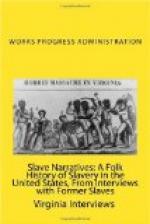“Ah never had no good times till ah was free”, the old man continued. “Ah was bo’n on Mastah Tolah’s (Henry Toler) plantation down in ole V’ginia, near Lynchburg in Campbell County. Mah pappy was a slave befo’ me, and mah mammy, too. His name was Gawge Washin’ton Tolah, and her’n was Lucy Tolah. We took ouah name from ouah ownah, and we lived in a cabin way back of the big house, me and mah pappy and mammy and two brothahs.
“They nevah mistreated me, neithah. They’s a whipping the slaves all the time, but ah run away all the time. And ah jus’ tell them—if they whipped me, ah’d kill ’em, and ah nevah did get a whippin’. If ah thought one was comin’ to me, Ah’d hide in the woods; then they’d send aftah me, and they say, ‘Come, on back—we won’t whip you’. But they killed some of the niggahs, whipped ’em to death. Ah guess they killed three or fo’ on Tolah’s place while ah was there.
“Ah nevah went to school. Learned to read and write mah name after ah was free in night school, but they nevah allowed us to have a book in ouah hand, and we couldn’t have no money neither. If we had money we had to tu’n it ovah to ouah ownah. Chu’ch was not allowed in ouah pa’t neithah. Ah go to the Meth’dist Chu’ch now, everybody ought to go. I think RELIGION MUST BE FINE, ’CAUSE GOD ALMIGHTY’S AT THE HEAD OF IT.”
Toler took a small piece of ice from the lard can, popped it between his toothless gum, smacking enjoyment, swished at the swarming flies with a soiled rag handkerchief, and continued.
“Ah nevah could unnerstand about ghos’es. Nevah did see one. Lots of folks tell about seein’ ghos’es, but ah nevah feared ’em. Ah was nevah raised up undah such supastitious believin’s.
“We was nevah allowed no pa’ties, and when they had goin’ ons at the big house, we had to clear out. Ah had to wo’k hard all the time every day in the week. Had to min’ the cows and calves, and when ah got older ah had to hoe in the field. Mastah Tolah had about 500 acres, so they tell me, and he had a lot of cows and ho’ses and oxens, and he was a big fa’mer. Ah’ve done about evahthing in mah life, blacksmith and stone mason, ca’penter, evahthing but brick-layin’. Ah was a blacksmith heah fo’ 36 yea’s. Learned it down at Tolah’s.
“Ah stayed on the plantation during the wah, and jes’ did what they tol’ me. Ah was 21 then. And ah walked 50 mile to vote for Gen’l Grant at Vaughn’s precinct. Ah voted fo’ him in two sessions, he run twice. And ah was 21 the fust time, cause they come and got me, and say, ’Come on now. You can vote now, you is 21.’ And theah now—mah age is right theah. ’Bout as close as you can get it.
“Ah was close to the battle front, and I seen all dem famous men. Seen Gen’l Lee, and Grant, and Abe Lincoln. Seen John Brown, and seen the seven men that was hung with him, but we wasn’t allowed to talk to any of ’em, jes’ looked on in the crowd. Jes’ spoke, and say ‘How d’ do.’




